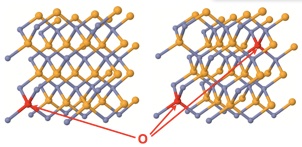Home / Research / Energy Conversion / Thermoelectrics / DOS
There are two different directions we are pursuing that relate to tuning the electronic properties of thermoelectric materials in order to increase the Seebeck coefficient, as opposed to lowering the thermal conductivity as in the nanostructured materials.
In one direction, we attempt to “engineer” the density of states in order to have a peak near the Fermi energy. This idea was present by Ma han and Sofo more than a decade ago, PNAS 93, 7436 (1996). As an example of how we can impact this problem using quantum mechanical, atomistic calculations, on the left is a unit cell of ZnSe with oxygen substitutionally doped for selenium (corresponding to 3% oxygen on the left and 6% on the right). By varying the oxygen concentration and averaging over relative positions of the dopants, we can predict the impact on the DOS. We can do this for a range of materials as well as dopants, and our calculations have found that certain combinations create large features in the DOS near the Fermi energy. We’ve demonstrated this effect for both p-type and n-type materials.
han and Sofo more than a decade ago, PNAS 93, 7436 (1996). As an example of how we can impact this problem using quantum mechanical, atomistic calculations, on the left is a unit cell of ZnSe with oxygen substitutionally doped for selenium (corresponding to 3% oxygen on the left and 6% on the right). By varying the oxygen concentration and averaging over relative positions of the dopants, we can predict the impact on the DOS. We can do this for a range of materials as well as dopants, and our calculations have found that certain combinations create large features in the DOS near the Fermi energy. We’ve demonstrated this effect for both p-type and n-type materials.

In another direction, we are exploring the use of hybrid materials....but more on this topic soon.
DOS-Engineered


Thermoelectrics

Massachusetts Institute of Technology, 77 Massachusetts Avenue, Cambridge MA 02139-4307

